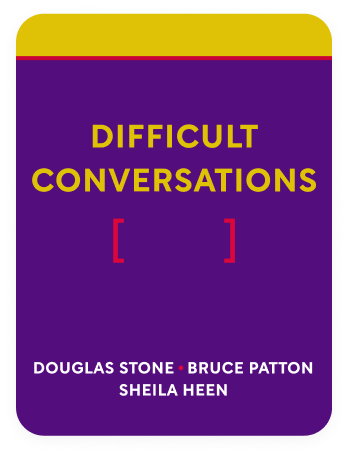

This article is an excerpt from the Shortform book guide to "Difficult Conversations" by Douglas Stone, Bruce Patton, Sheila Heen. Shortform has the world's best summaries and analyses of books you should be reading.
Like this article? Sign up for a free trial here .
How do you start a challenging conversation? What can you say to raise the issue in a way that sets the tone for an open and constructive discussion?
Starting a challenging conversation is nerve-wracking. Most of us treat it like we treat swimming—we close our eyes and just jump in, but this is hardly the best way to go about it.
Here is how to start a challenging conversation in a way that sets the tone for an open and non-judgemental exchange.
How to Start a Challenging Conversation
The beginning of a challenging conversation is usually the most stressful moment, where we either learn that bad news is coming our way, or that the person we’re talking to is going to get upset. With that in mind, here are the attitudes to take into a challenging conversation:
- Replace certainty with curiosity. Don’t believe that your story is the one right story. Challenge why you believe what you do, and ask what you don’t know. Then be curious about someone else’s story and ask questions.
- Adopt the And Stance. Embrace that both sides’ stories are valid.
- Don’t assume bad intentions of the other person. Just because you feel bad doesn’t mean the other person wanted you to feel bad. Ask what the other person said or did exactly, and what assumptions you’re making about the intention behind it.
- Even go in assuming good intentions, and phrase things accordingly — “I was surprised by your comment” or “I thought that action was out of character” imply that you do think they’re a good person.
- Question your own intentions. If someone accuses you of harboring bad intentions, avoid being defensive as a reflex. Is it possible you had mixed intentions?
Two Bad Openings
These are the two most common ways we start a challenging conversation and the two least helpful ways to do so:
1. We start in directly with our own perspective. If the other person agreed with how we saw things, we wouldn’t be having the difficult conversation. Most of the time, the other person doesn’t know there’s an issue, or has their own perspective on it — so going in with our own perspective right away can make it seem like we aren’t interested in solving the problem together.
2. We express judgments about their character, and trigger their identity conversation immediately. This is why it’s so important to do away with judgments. The issue is not a judgment on the other person’s character, it’s an instance of friction between two people. Especially at the beginning of a difficult conversation, dispensing judgments shows you’re not really interested in a conversation or your own contribution.
Sometimes the opening lines are deceptively judgmental, even when you’re trying to discuss your intentions.
- What is said: “I was upset by what you said to our boss about our work.” What is implied: “You are either a betraying scumbag, or you were dumb enough not to realize the ramifications.”
- What is said: “If you move away, it’s going to tear the family apart.” What is implied: “You’re selfish and don’t care about the family.”
Both of these beginnings are common because they’re based in how we see things — but they also immediately put the other person on the defensive. If the tables were turned, and the other person started a challenging conversation by insulting your character, would you be willing to sit and listen to them explain further?
The Correct First Two Steps
If your purpose is to understand the other person’s story, express yourself, and solve the problem together, you need to start the conversation off to set the tone for those things to happen. Start with these two steps.
First, Start From the Third Story
The Third Story is the objective story a mediator or other 3rd party would tell about the current situation. Mediators try to tell the third story in a way that makes both parties feel understood. The goal of the Third Story is to tell a story that both parties can agree to. It requires them to understand each party’s feelings and use the And Stance to connect the actions and impact that caused the issue.
Mediators know that no one view is right or wrong, they’re just different. The Third Story sets out to illuminate the difference between the views. For example, a mediator working with two roommates on an issue about who does the dishes might summarize it this way: “Jason and Jill have different preferences around when the dishes are done and what constitutes appropriate cleanliness. Each is unhappy with the other’s approach.”
To start from the Third Story, you don’t have to know the other person’s story, you can just focus on the difference. “I was taught that dishes should be done immediately after you use them, and that it’s a sign of disrespect to leave dirty dishes in the sink — but it seems like you have a different perspective.”
Starting from the Third Story doesn’t mean giving up your point of view, it means starting from a neutral place so you can invite the other person to share and participate in the conversation. Starting from the Third Story shows we care about the other person and are trying to improve the relationship for both people.
Even if you don’t get to start the difficult conversation, you can still bring in the Third Story at the earliest opportunity. Use what the other person said as their side of the Third Story, and bring it back around to the difference between your perspectives and your desire to explore the issue.
Then, Invite Them to Participate
Once you’ve told the Third Story in a way that both parties can agree to, you essentially have to invite the other person to join you in a conversation about mutual understanding and problem-solving.
Express your purpose up front. You want to understand their side better, share your side, and then discuss how to move forward. For them to agree to participate, they need to know what they’re agreeing to. This also helps focus them on the right purpose.
But remember: invitations can be refused. You can’t force someone to participate, no matter how badly you want to. You can only invite, and then it’s up to them to agree or refuse.
Explicitly put them in the role of your partner in the tasks at hand. They’re not solely the problem, and you need them to work this issue out. Let them know that they have equal footing in the conversation (if that’s true), and that finding a satisfactory solution depends on their involvement.
Here are some phrases to use that invite the other person to participate:
- “Can you help me understand…” makes them an advisor on what’s going on.
- “Let’s work on how we might…” suggests a partnership.
- “I wonder if it’s possible…” issues a respectful challenge and allows the other person to ride in and be the hero.
The partnership has to be offered genuinely, or it won’t be received well because it won’t seem like you really mean it. If you’re having trouble viewing them as a partner and not just the problem, be open about that: “The story I’m telling myself is that you’re being inconsiderate. I know that’s unfair to you. Help me put this in perspective and better understand where you’re coming from.”
Finally, remember to be persistent. This doesn’t mean you can force them to participate, but you might have to work to get them to understand what you’re asking for. Most people aren’t used to being treated as an equal in a difficult conversation, so it could take some time to shift their mindset about how you’re trying to have the conversation.
General Advice for Starting a Challenging Conversation
Here’s a good structure for approaching the beginning of any challenging conversation:
- Start with the Third Story.
- Try to understand their story.
- Share your story.
This structure will go the farthest in bringing the other person along with you and easing them into the difficult conversation.
You can also help guide them through the 3 Conversations — What Happened, Feelings, and Identity — by asking questions or explaining the conversations to them. Each of you should talk about past experiences that have influenced how you see the current situation. Ask about the other person’s intentions and share the impact their actions had on you. Share what’s going on in your Identity Conversation, and ask what might be going on for them.
Of course, a real conversation is interactive, and it won’t necessarily go exactly according to schedule. But once you understand the components, you can work with them on the fly. To understand the other person’s perspective, you’ll need to improve your skills of asking, listening, and acknowledging. To share your perspective, you’ll have to hone your sense of deserving to share your story, and improve your ability to share it concisely. To keep a difficult conversation on track, you’ll have to develop your ability to negotiate it back into the correct focus, if and when it starts to veer off course.
Three Conversations That Might Be More Difficult to Start
Some conversations might feel like they’re harder work than others. Here are 3 common conversations that feel more difficult, and some ways you can make them a little easier:
The Bad News Conversation
Sometimes, you’ve got to be the bearer of bad news — firing someone, breaking up with someone, and so on — but you should still aim to have a conversation. It doesn’t mean you’re going to change your mind, but it does mean you respect the other person enough to want them to understand your side and share their side, and to resolve as many of the negative feelings as possible.
It’s best to deliver the bad news first — don’t draw out conversations where you’ve already decided.
- For example, if you’re calling to tell your mother you’ve decided to have your own Christmas instead of attending the family Christmas, start there. “We’ve decided that we’re going to spend Christmas here. I know it’s important to you that we come home for the holidays and I feel guilty about disappointing you, but it’s just too difficult for us financially and emotionally this year to do that. I wanted to let you know as soon as possible, and maybe talk more about our reasoning and how it makes you feel.”
If there’s good and bad news, specify that you have both. There may be a logical order to deliver the news in, or you can let the other person decide what they’d like to hear first.
Asking for Something
Sometimes difficult conversations are focused on our desire for something, such as a raise. It can feel one-sided in a different way: “I want a raise, so I’ve got to talk my boss into giving me one.” But these, too, should be conversations instead of demands.
It’s best to still invite the other person to participate and explore the issue with you. It isn’t unassertive to approach the conversation this way — it’s more realistic. If you’re asking your boss for a raise, you can’t strongarm them into giving you one, you need them to agree that you deserve one.
“I wonder if it would make sense…” is a great phrase to use in these conversations. “I’d like to explore…” is another one.
Previously Difficult Conversations
Sometimes we’ve already had a difficult conversation where someone reacted badly, so it makes us hesitant to enter into the conversation again and get the same bad reaction.
The first step is to talk about how to talk about it this time. The real issue now is the way this conversation goes based on past experiences.
Start with a Third Story about that: “I know that when I’ve tried to talk to you about how busy your schedule is in the past, you’ve felt annoyed or agitated. That’s not my goal. I’m just worried about you. I wonder if we can talk about how to address this issue for both of us, and if there’s a better way the conversation could be had.”

———End of Preview———
Like what you just read? Read the rest of the world's best book summary and analysis of Douglas Stone, Bruce Patton, Sheila Heen's "Difficult Conversations" at Shortform .
Here's what you'll find in our full Difficult Conversations summary :
- Why healthy relationships need difficult conversations
- The 3 conversations that happen within each difficult conversation
- How difficult conversations go wrong and what to do about it






